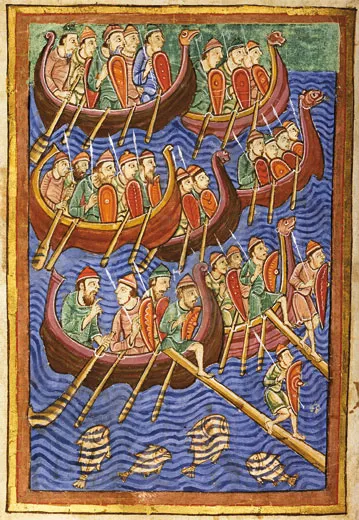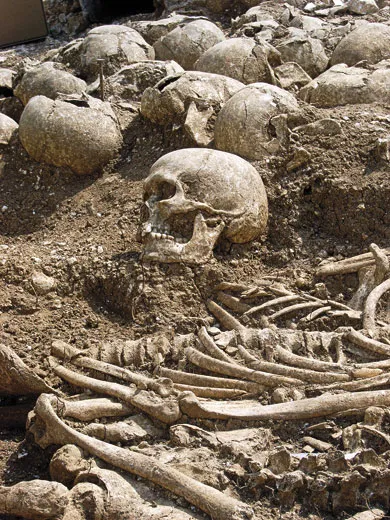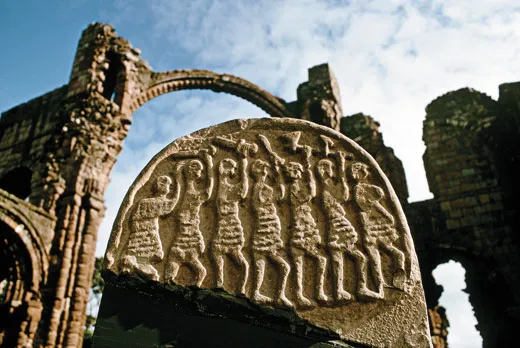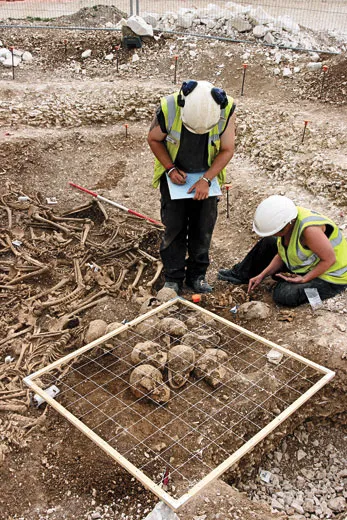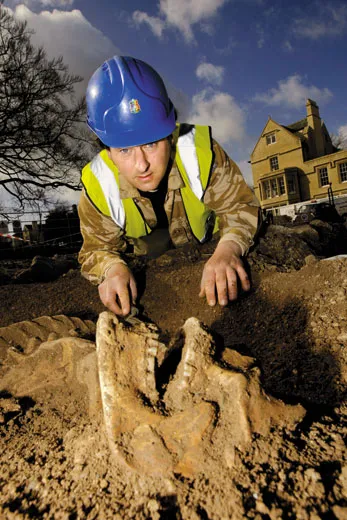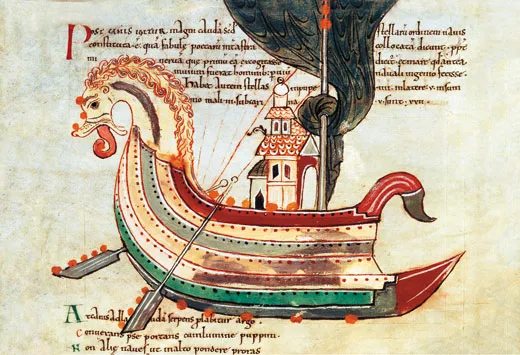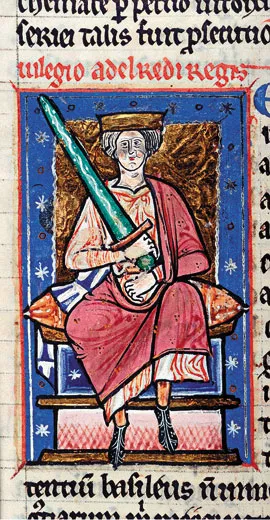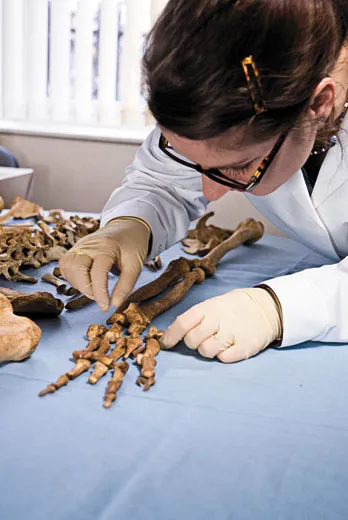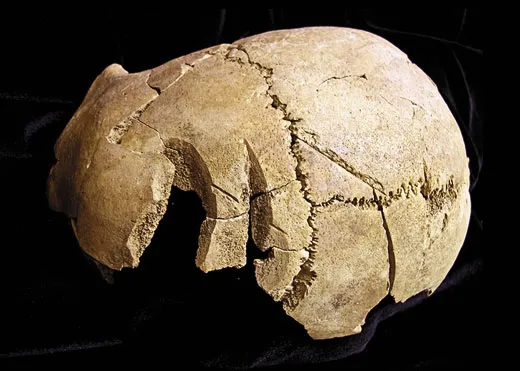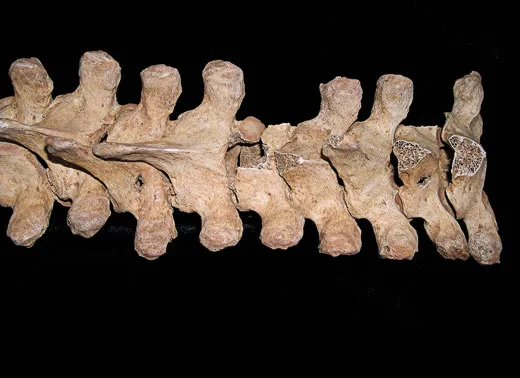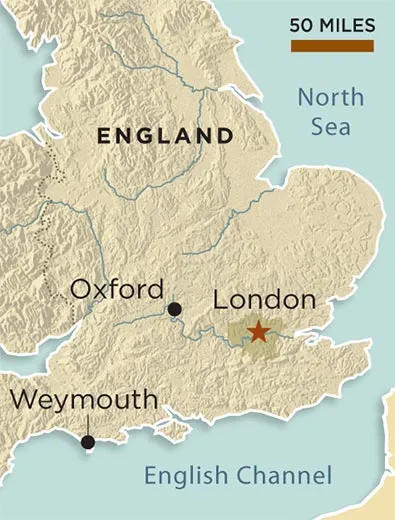A Viking Mystery
Beneath Oxford University, archaeologists have uncovered a medieval city that altered the course of English history
/https://tf-cmsv2-smithsonianmag-media.s3.amazonaws.com/filer/Vikings-mass-grave-631.jpg)
Before construction could begin on new student housing at one of Oxford University’s 38 colleges, St. John’s, archaeologists were summoned to investigate the site in January 2008. After just a few hours of digging, one archaeologist discovered the remains of a 4,000-year-old religious complex—an earthwork enclosure, or henge, built by late Neolithic tribesmen, probably for a sun-worshiping cult. About 400 feet in diameter, the temple was one of the largest of Britain’s prehistoric henges, of which more than 100 have been found.
Later, the archaeologists found pits full of broken pottery and food debris suggesting that people had used the henge as a medieval garbage dump millennia after it had been dug. Excited, they began searching for items that might reveal details of daily life in the Middle Ages. Instead they found bones. Human bones.
“At first we thought it was just the remains of one individual,” says Sean Wallis of Thames Valley Archaeological Services, the company that did the excavating. “Then, to our surprise, we realized that corpses had been dumped one on top of another. Wherever we dug, there were more of them. Not only did we have a 4,000-year-old prehistoric temple, but now a mass grave as well.”
After one month of digging at the grave site and two years of lab tests, the researchers concluded that between 34 and 38 individuals were buried in the grave, all of them victims of violence. Some 20 skeletons bore punctures in their vertebrae and pelvic bones, and 27 skulls were broken or cracked, indicating traumatic head injury. To judge from markings on the ribs, at least a dozen had been stabbed in the back. One individual had been decapitated; attempts were made on five others.
Radiocarbon analysis of the bones convinced the archaeologists that the remains date from A.D. 960 to 1020—the period in which the Anglo-Saxon monarchy peaked in power. Originally from Germany, Anglo-Saxons had invaded England almost six centuries earlier, after the Roman Empire had fallen into disarray. They established their own kingdoms and converted to Christianity. After decades of conflict, England enjoyed a degree of stability in the tenth century under the rule of King Edgar the Peaceful.
But “peaceful” is a relative term. Public executions were common. British archaeologists have discovered some 20 “execution cemeteries” across the country—testifying to a harsh penal code that claimed the lives of up to 3 percent of the male population. One such site in East Yorkshire contains the remains of six decapitated individuals.
The Oxford grave, however, didn’t fit the profile of an execution cemetery, which typically contains remains of people put to death over many centuries—not all at once, as at Oxford. And execution victims tended to be various ages and body types. By contrast, the bodies buried at Oxford were those of vigorous males of fighting age, most between 16 and 35 years old. Most were unusually large; an examination of the muscle-attachment areas of their bones revealed extremely robust physiques. Some victims had suffered serious burns to their heads, backs, pelvic regions and arms.
The most telling clue would emerge from a lab analysis, in which scientists measured atomic variations within the skeletal bone collagen. The tests indicated that the men ate, on average, more fish and shellfish than did Anglo-Saxons.
The mounting evidence increasingly pointed to an astonishing conclusion: this was a mass grave of Viking warriors.
In the late eighth century a.d., the Vikings—a Scandinavian people from Denmark, Norway and Sweden—began a 300-year campaign of pillaging and piracy throughout Europe. Some scholars say that political changes (especially the emergence of fewer yet more powerful rulers) forced local Viking chieftains to seek new sources of revenue through foreign conquests. Others point to advances in shipbuilding that enabled longer voyages—allowing the Vikings to establish trade networks extending as far as the Mediterranean. But when an economic recession hit Europe in the ninth century, Scandinavian seamen increasingly turned from trading to pillaging.
Most historians believe that England suffered more from the Vikings than other European countries. In the first recorded attack, in A.D. 793, Vikings raided an undefended monastic community at Lindisfarne in the northeast. Alcuin of York, an Anglo-Saxon scholar, recorded the onslaught: “We and our fathers have now lived in this fair land for nearly three hundred and fifty years, and never before has such a terror been seen in Britain as we have now suffered at the hands of a pagan people. Such a voyage was not thought possible. The church of St. Cuthbert is spattered with the blood of the priests of God.”
The Anglo-Saxon Chronicle, a contemporary historical account, records that the Vikings waged some 50 battles and destroyed or ravaged scores of settlements. Dublin, one of the largest Viking cities in the British Isles, became a major European slave-trading center, where, historians estimate, tens of thousands of kidnapped Irishmen, Scotsmen, Anglo-Saxons and others were bought and sold.
“In many respects the Vikings were the medieval equivalent of organized crime,” says Simon Keynes, a professor of Anglo-Saxon history at Cambridge University. “They engaged in extortion on a massive scale, using the threat of violence to extract vast quantities of silver from England and some other vulnerable western European states.”
“Certainly the Vikings did all these things, but so did everyone else,” says Dagfinn Skre, a professor of archaeology at the University of Oslo. “Although admittedly, the Vikings did it on a grander scale.”
Martin Carver, an emeritus professor of archaeology at the University of York, characterizes the antagonism between the Anglo-Saxons and the Scandinavians as part of a wider clash of ideologies. Between the sixth and ninth centuries, Vikings in Scandinavia preferred to be organized “in loose confederations, favoring enterprise,” says Carver. But other parts of Europe, such as Britain, yearned for a more orderly, centralized government—and looked to the Roman Empire as a model.
Only one Anglo-Saxon kingdom—Wessex, ruled by Alfred the Great—is known to have withstood the Viking invasion. Alfred and his son, Edward, built up an army and navy and constructed a network of fortifications; then Edward and his successors wrested back control of those areas the Vikings had taken over, thus paving the way for English unification.
After decades of peace, Vikings again raided England, in A.D. 980. At the time, the Anglo-Saxon ruler was King Aethelred the Unraed (literally “the ill-advised”). As his name suggests, popular history has portrayed him as a mediocre successor to Alfred the Great and Edgar the Peaceful. The 12th-century historian William of Malmesbury wrote that Aethelred “occupied rather than governed” the kingdom. “The career of his life was said to have been cruel in the beginning, wretched in the middle and disgraceful in the end.”
To avert war, Aethelred paid the Vikings some 26,000 pounds in silver between A.D. 991 and 994. In the years that followed, the king employed many of them as mercenaries to discourage other Vikings from attacking England.
But, in A.D. 997, some of the mercenaries turned on their royal employer and attacked the Anglo-Saxon southern counties. In early A.D. 1002, Aethelred again tried to buy off the Vikings—this time with 24,000 pounds in silver.
The geopolitical situation changed in England’s favor only when Aethelred made an alliance with Normandy and sealed the deal by marrying the Duke of Normandy’s sister in A.D. 1002. Possibly emboldened by the support of a powerful ally, Aethelred decided to take pre-emptive action before the Danes again broke the truce.
According to the Anglo-Saxon Chronicle, Aethelred was “informed” that Danish mercenaries intended to “beguile him out of his life.” (It is unknown whether an informer learned of an actual plot, or if Aethelred and his council fabricated the threat.) Aethelred then set in motion one of the most heinous acts of mass murder in English history, committed on St. Brice’s Day, November 13, 1002. As he himself recounted in a charter written two years later, “a decree was sent out by me, with the counsel of my leading men and magnates, to the effect that all the Danes who had sprung up in this island, sprouting like cockle [weeds] amongst the wheat, were to be destroyed by a most just extermination.”
Prior to 2008, the only known inhabitants of the St. John’s College garden had been the songbirds and squirrels that darted across the neatly cropped lawn and hid in an ancient beech tree. Generations of dons and students had strolled across that greenery, unsuspecting of what lay beneath.
The lab data indicating that the men buried there for 1,000 years had eaten lots of seafood, plus the burn markings and other evidence, convinced the archaeologists that the grave probably held victims of the St. Brice’s Day massacre. Aethelred himself recounted exactly how the residents of Oxford killed the Danes in a local church: “Striving to escape death, [the Danes] entered [a] sanctuary of Christ, having broken by force the doors and bolts, and resolved to make a refuge and defence for themselves therein against the people of the town and the suburbs; but when all the people in pursuit strove, forced by necessity, to drive them out, and could not, they set fire to the [building’s] timbers and burnt [it] down.”
Wallis, the archaeologist in charge at Oxford, surmises that the townspeople loaded the corpses onto a cart and drove out through the north gate of the city, past land that today encompasses the Oxford colleges of Balliol and most of St. John’s, then threw the Vikings into the prehistoric henge—the largest ditch nearest the city’s northern exit.
A year after this discovery, another team of investigators, from the company Oxford Archaeology, were looking for evidence of prehistoric activity at a site 90 miles to the southwest in the English county of Dorset, near Weymouth, when they discovered a second mass grave. This one held the skeletons of 54 well-built, fighting-age males, all of whom had been decapitated with sharp weapons, most likely swords. Lab tests of the teeth suggested the men were Scandinavians. The ratio between various types of oxygen atoms in the skeletons’ tooth enamel indicates the victims came from a cold region (one man from inside the Arctic Circle). Radiocarbon dating placed the victims’ deaths between A.D. 910 and 1030; historical records of Viking activities in England narrow that to between A.D. 980 and 1009. The corpses had been unceremoniously dumped in a chalk and flint quarry that had been dug hundreds of years earlier, possibly during Roman times. Although no historical account of the massacre exists, the archaeologists believe the Vikings were apprehended and brought to the site to be executed.
The discovery of the two mass graves may resolve a question that has long vexed historians. In the centuries following the St. Brice’s Day massacre, many chroniclers believed that the Danish community in England (a substantial percentage of the population) was targeted for mass murder, akin to a pogrom. Certainly there was undisguised hatred for the Scandinavians, who were described by contemporary writers as “a most vile people,” “a filthy pestilence” and “the hated ones.” But more recently, the massacre has been seen more as a police action against only those who posed a military threat to the government. The discovery of the two mass graves supports this view, since victims were found where the rebellious mercenaries would have been stationed: close to royal administrative centers (usually towns or important royal estates) on or near England’s south coast and in the Thames Valley. By contrast, no such graves have been found in the region of eastern England once known as the Danelaw, which was populated by descendants of Scandinavian settlers. “I would estimate that out of a total population of around two million in England, perhaps half were of Scandinavian or partly Scandinavian origin—most of whom were loyal subjects,” says Ian Howard, a historian writing a biography of Aethelred. “I think it inherently unlikely that the king ever intended to kill them all, as it would obviously have been impossible to do so.”
Far from being just a ghoulish footnote to medieval history, Aethelred’s massacre of the Danes likely reinforced Danish determination to attack England and set in motion a chain of events that would change the course of England’s future. In A.D. 1003, the year after the massacres, King Svein of Denmark launched his own assault against a much wider swath of Anglo-Saxon England. This renewed aggression continued off and on for more than a decade, inspiring a level of terror the Anglo-Saxons had not faced since the first Viking invasions a century and a half earlier. An Anglo-Danish text, the Encomium Emmae Reginae, written around A.D. 1041 or 1042, described the Danish war fleet of 1016: “What adversary could gaze upon the lions, terrible in the glitter of their gold...all these on the ships, and not feel dread and fear in the face of a king with so great a fighting force?”
Both circumstantial and historical evidence suggests that revenge was at least part of the motivation for Svein’s invasions. There were almost certainly blood ties between Aethelred’s victims and Danish nobility. According to medieval chronicler William of Malmesbury, Svein’s sister (or, possibly, half sister) Gunnhild was a victim of the St. Brice’s Day massacre (although her body has never been found). Neither her gender nor her royal blood saved her, probably because she was the wife of Pallig, one of the turncoat mercenaries. Wrote William of Malmesbury: “[She was] beheaded with the other Danes, though she declared plainly that the shedding of her blood would cost all England dear.”
Gunnhild’s words proved prophetic. The Danes ultimately conquered England, in A.D. 1016, and Canute, the son of Svein, was crowned the nation’s king in London’s St. Paul’s Cathedral in January 1017. Twenty-five years later, the Anglo-Saxons would regain the crown, but only for a generation. The Scandinavians, who had refused to renounce the throne, embarked on yet another onslaught against England in September 1066—less than a fortnight before William the Conqueror, the Duke of Normandy, launched his own invasion of the country.
Although the English pushed back the Scandinavian invaders, the effort so weakened the Anglo-Saxons that they were defeated by William at the Battle of Hastings, also in 1066. The Norman Conquest consolidated the unification of England, as the new rulers introduced a more centralized, hierarchal government. The Anglo-Saxons would rise again, their culture and language merging with that of their oppressors to produce a new nation—the predecessor of modern England, and eventually an empire that would span half the globe.
David Keys is The Independent’s archaeology correspondent.
